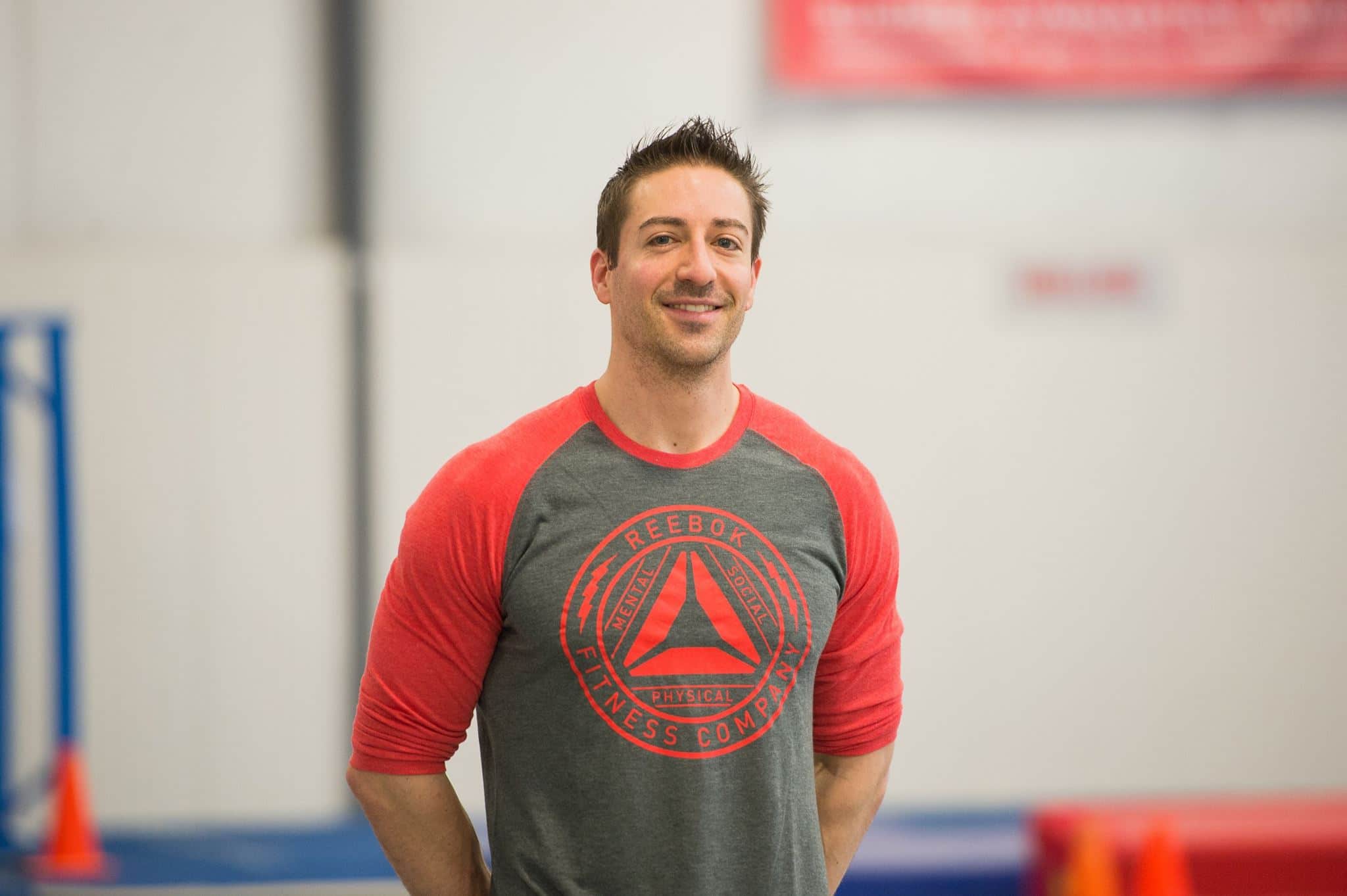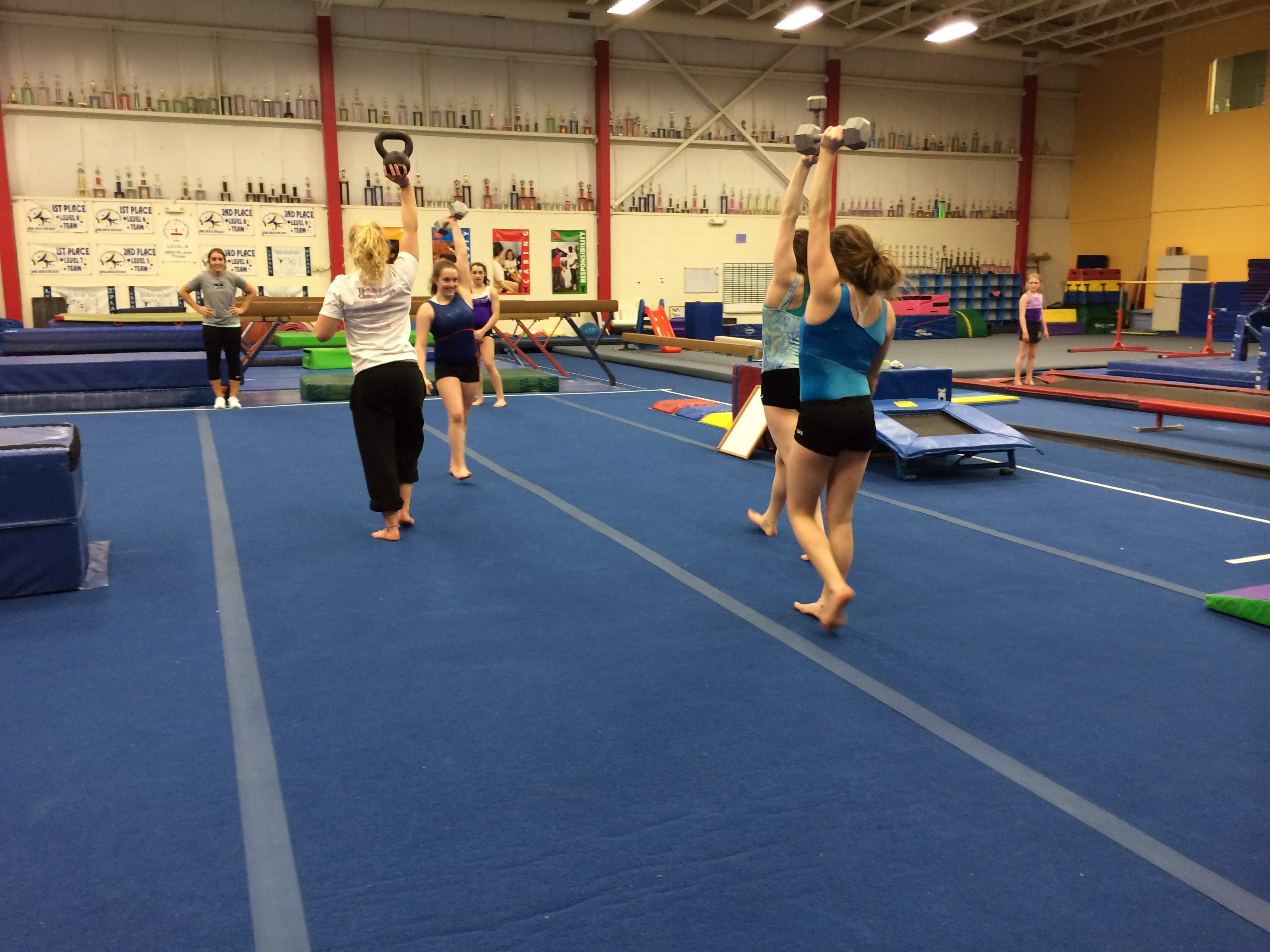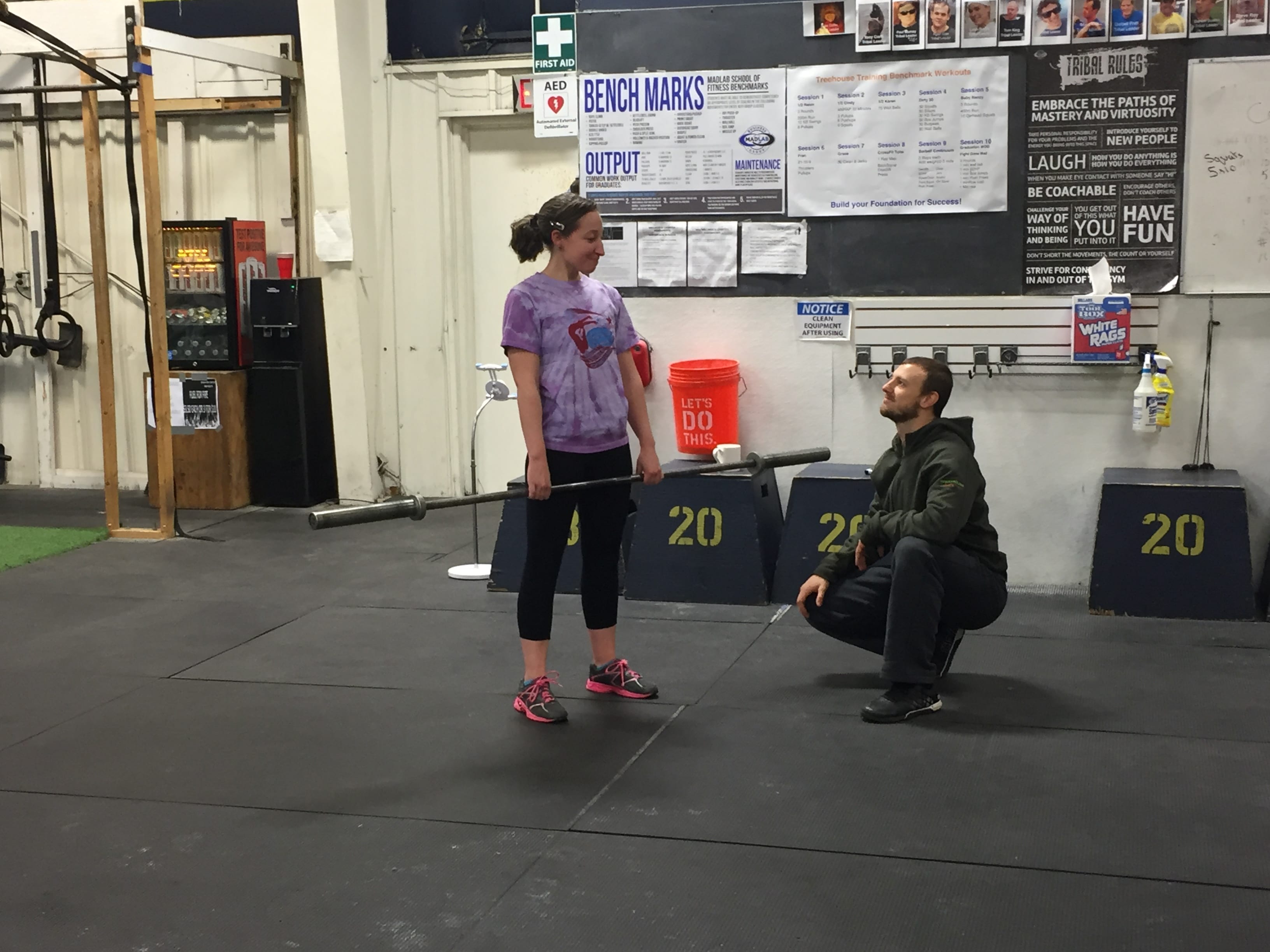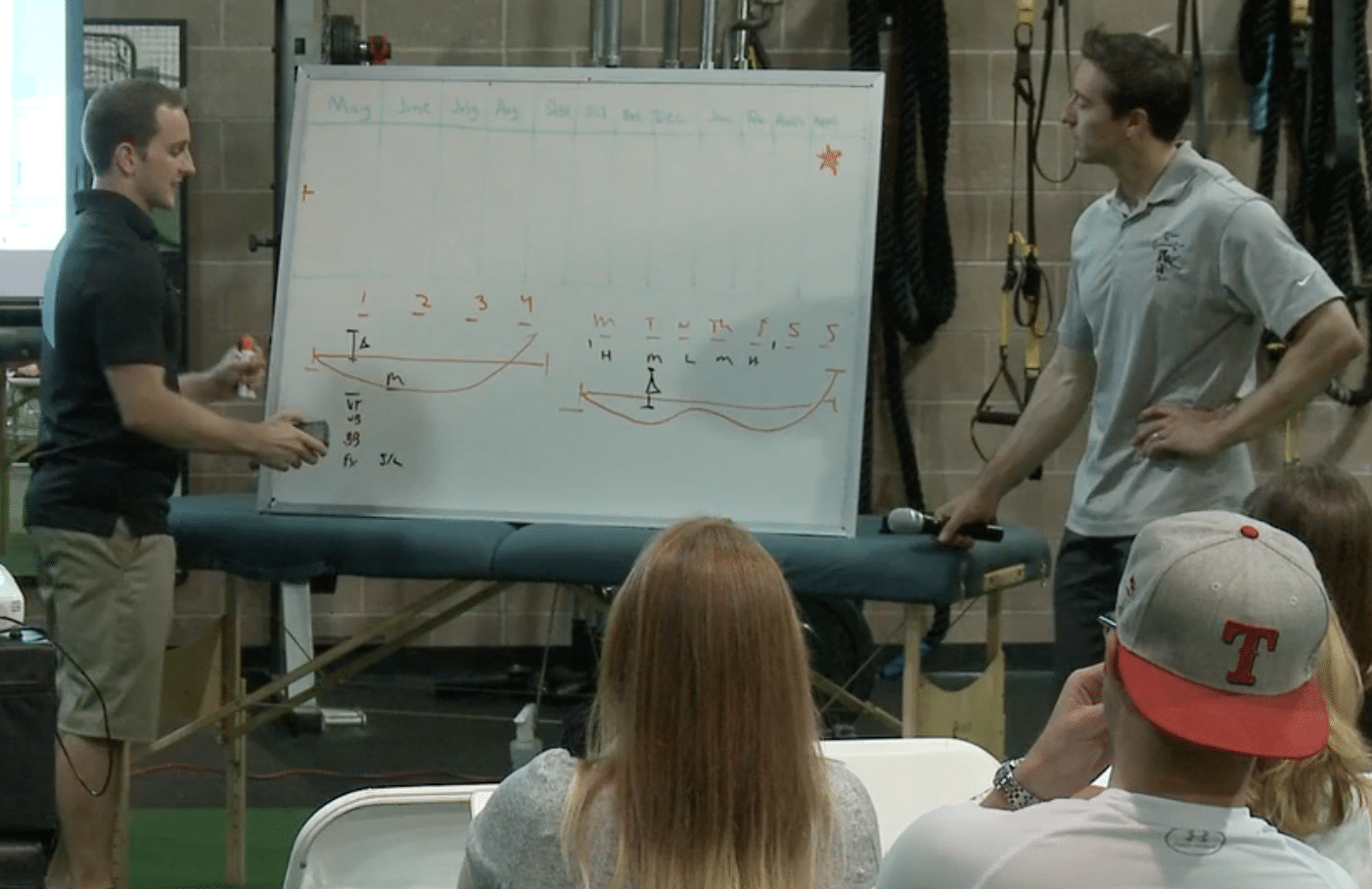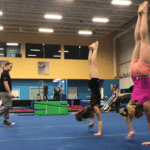Guest Post By Rupert Egan: Gymnastics Periodization To Maximize Performance (Part 1)
Today I’m super excited to start a guest post series from my friend Rupert Egan. I originally starting talking with Rupert last year regarding strength and conditioning concepts for gymnasts. I recently had the chance to spend a week with him talking shop at Power Monkey Camp. Rupert was a collegiate gymnast at William & Mary, has been coaching for quite a few years, has his bachelors in Neuroscience as well as his Masters in Physiology, and specializes in gymnastics periodization concepts. He follows a lot of the strength and conditioning research and is also a big Dr. Sands fan. I’ve learned a ton from Rupert and have been incorporating his ideas into the hybrid model I’m building for our gymnastics team.
I feel the concept of planning cycles and periodization is crucial to gymnastics for both performance and injury prevention, so I asked Rupert if he would be willing to do a guest post series on some gymnastics applications. Big thanks to Rupert, and enjoy some great content.
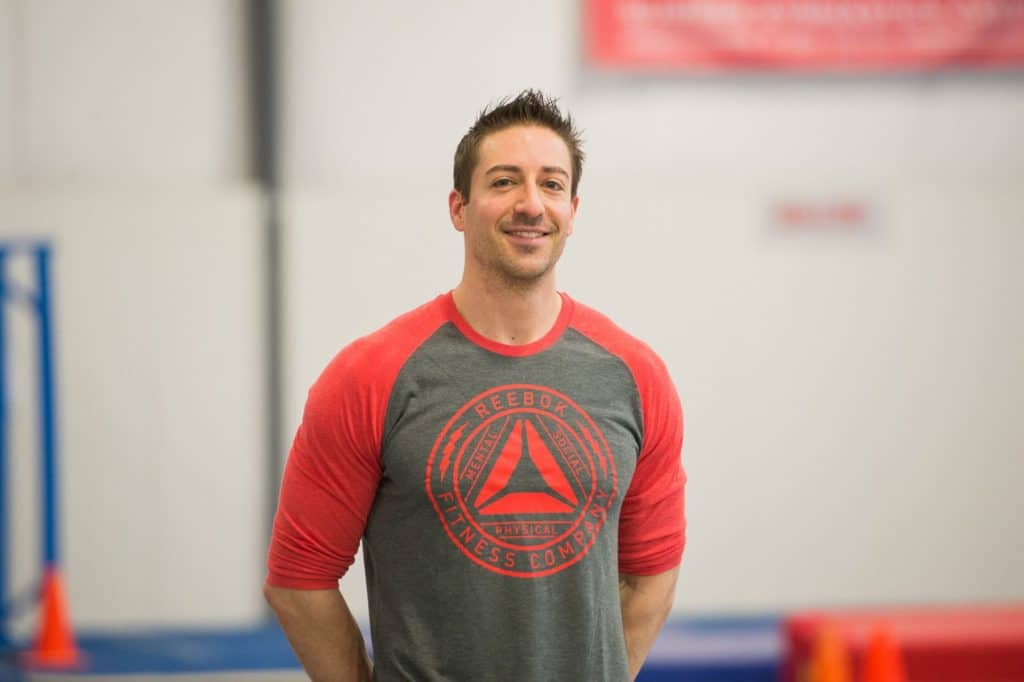

Table of Contents
Four Phases of the Annual Plan:
How and why to implement a periodized approach to your gym’s strength and conditioning
Key Points:
The primary aim of this post is to serve as a reference for coaches to aid in their development and implementation of a progressive, systematic strength and conditioning program that covers an entire competitive calendar year. A successful program should strive to develop and refine a systematic method for achieving proper athlete development through the course of a season, and ideally the duration of that athlete’s entire competitive career. A comprehensive strength program should intentionally moderate the athlete’s training in a manner that ensures reduced risk of injury while also allowing for appropriate strength and skill development. The conceptual model presented here is called a monocycle periodization model. This model is useful when a coach is attempting to have their athletes peak for a single competition (ex- J.O. Nationals at the end of the competitive season).

Short Summary:
There are four general phases of the annual plan –
- Off Season/anatomical adaptation phase/General Physical Preparation phase (GPP)
- Pre-season (Max strength and power development)
- In-season (energy system training, routine specific development, and strength/power development and maintenance)
- Post-season (active recovery)
The competitive year is broken up into blocks of time (usually 4-6 weeks). Each block is referred to as a mesocycle. These blocks can be further broken down into smaller blocks (microcycles), usually a week in duration. Begin planning by starting from your last major competition of the season (ex- JO Nationals) and work your way backward when designing your program.
The goal of any strength and conditioning program should be to develop a sound training process that improves gymnastics potential and performance while also reducing potential injuries. Tracking your athlete’s development is an integral part of this process. It is important to note that it is difficult to draw causation between specific strength numbers and actual gymnastics performance. That does not mean that there will not be a correlation or association between certain metrics and gymnastics development. It simply means that as a coach you should not push specific numbers or emphasize a certain strength metric with an expectation that these metrics will then allow your athletes to perform specific skills/sequences.

There is certainly a minimum base of strength that is required from a safety perspective, especially in regards to joint stability, but super high levels of strength are not the end goal. Increased speed of application (rate of force development) and sound movement pattern development will translate most directly to skills. Therefore, a large portion of an annual program should be focused on general strength development and stress quality movement. For a gymnast, the focus will predominantly be on relative strength development.
Gymnasts however have similar needs to other athletes in that in order to be successful (and injury free) they must possess strong hips, legs, shoulders, arms, and midsections that function in a coordinated and integrated manner. Therefore, a gymnast’s strength training program should not exactly mimic the specific nature of gymnastics skills.
A high level of General Physical Preparedness (GPP) must be achieved in addition to the development of specific gymnastics-based strength (SGBS) and proper technical progression/drills. A strength and conditioning program will need to differentiate between general strength training and proper movement patterning and Gymnastics-Based Positioning and Shaping exercises (SGBS), taking into account the comprehensive training load of each respectively.
Within each strength training program there should be a degree of flexibility to allow for the individualized needs of each of your athletes. A successful program will address the mobility and movement issues of each athlete. This is referred to as the corrective exercise or prehab component of a program. Again, there needs to be a balance between each component and a proper emphasis of each at the appropriate time in the competitive year. When preparing your athletes they should be mobile enough to achieve the proper positions in gymnastics, and strong and explosive enough to move from and through these positions dynamically and in a safe and integrated manner.
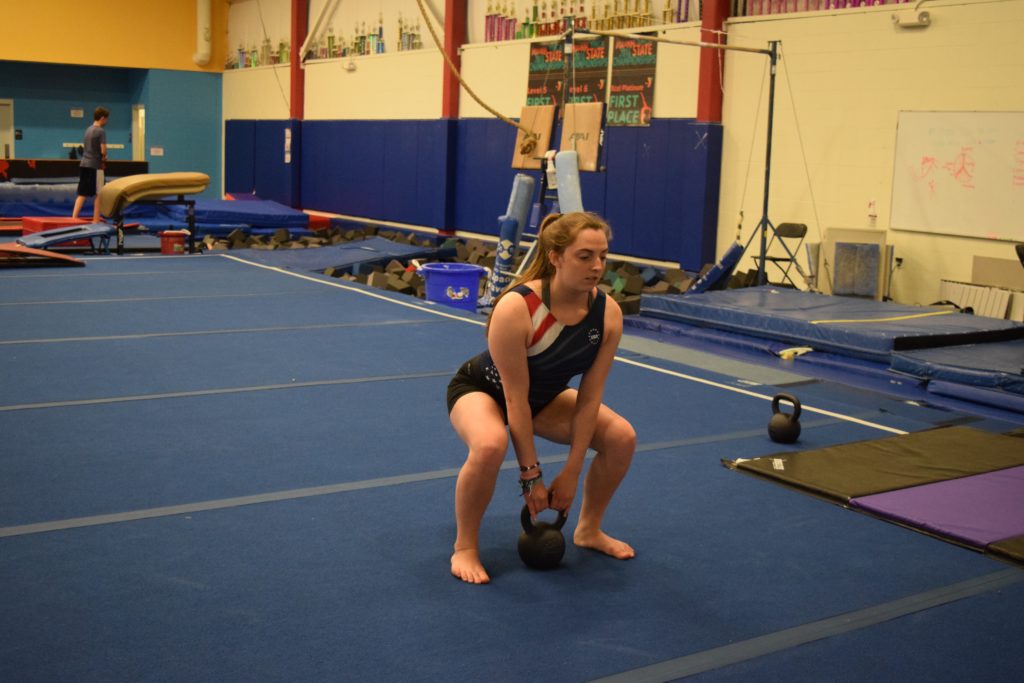
Key Concepts or The Nuts and Bolts of Building Your Program
Training Variables: These are the factors that you as a coach must manage in order to drive adaptation of the athlete in the desired direction. The primary overall training variables are Intensity of training and strength and conditioning work, the total training volume (think total turns, number of routines, 1/2 routines, sequences, and finally the total duration of training) either in a day, or over the course of a longer period of time (week, month, year). As a coach, these are you tools that you use to moderate training factors:
Progression, Overload, Variation, & Specificity
Types of strength work:
- Max Effort (strength)
- Repetition training- Sports specific metabolic work (pre and in-season), specific muscular endurance
- Dynamic Effort (explosive power)
- Recovery-crucial during in-season training
Set/reps schemes should be based on an understanding of bioenergetics as well as gymnastics training knowledge and experience.
Microcycle
In training methodology a microcycle is a weekly or 3 to 7- day training program within an annual program. According to most periodization literature, the microcycle is the most important functional planning tool in the training process. The microcycle is structured according to the objectives, volume, intensity, duration, and method that are the focus of the training phase. The physiological and psychological demands placed on the athlete cannot be steady; they must change according to the athlete’s working capacity, the athlete’s need for recovery, and the competition plan. The microcycle must be flexible enough that individual training sessions can be modified to address certain circumstances. When the microcycle is modified, subsequent training lessons must be modified to maintain the focus of the microcycle and ensure that the training objectives are achieved.
Macrocycle
A training macrocycle is a phase that lasts 2 to 7 weeks. A macrocycle therefore contains 2 to 7 microcycles. The microcycle is used to plan for the immediate future, whereas the macrocycle projects the structure of a training program several weeks in advance. Therefore, one could think of the macrocycle as the general structure of training and the microcycle as the exact method used to accomplish the targeted goals.
(From Periodization: Theory and Methodology of Training by Tudor O. Bompa and G. Gregory Haff)
Anatomical Adaptation Mesocycle
This mesocycle should follow shortly after the end of season (after a period of active recovery). For gymnastics focused strength training this is perhaps the easiest mesocycle to program because it is based on an increasing volume paradigm which gymnastics (and body weight training) leans itself to quite well. For practical purposes and to get in a higher level of volume it is suggested that some priming strength training take place before actual gymnastics training. The bulk of the strength training should then take place after skill and event training. The goal here is to generate some morphological changes in the athlete’s muscle tissue (increase lean mass) and increase strength to weight ratio endurance.

Strength Development Mesocycle
Strength is one of the most important abilities for most sports. It is the foundation for both generating maximal power and maintaining repetitive muscular contractions (muscular endurance). To fully benefit from a strength training cycle it must be integrated into the comprehensive periodized training plan at the appropriate time in the season. Simply adding strength training without considering the other training activities or point in the season in which it takes place will not maximize performance outcomes.
This mesocycle follows the anatomical adaptation mesocycle and is designed to increase the maximum and relative strength of the athletes. This mesocycle is based on an increasing intensity paradigm within a blocked repetition training cycle. Weight and repetition numbers and improvements will be tracked and athletes should see an objective measure of their progress, especially if this phase is extended to cover at least two full cycles of the basic 4 week mesocycle.

Power Development Mesocycle
The goal of this mesocycle is to convert the strength that has been developed during the AA and MS mesocycles to more gymnastics-specific applications. The general goals is for the athletes to begin to generate as much force as possible in as short a time period as possible in order to affect tumbling and vault amplitude (see Dr. Sand’s comprehensive works). Additionally, jump height for leaps are another area of focus. Upper body explosiveness is also emphasized to help with bars amplitude and skills development.
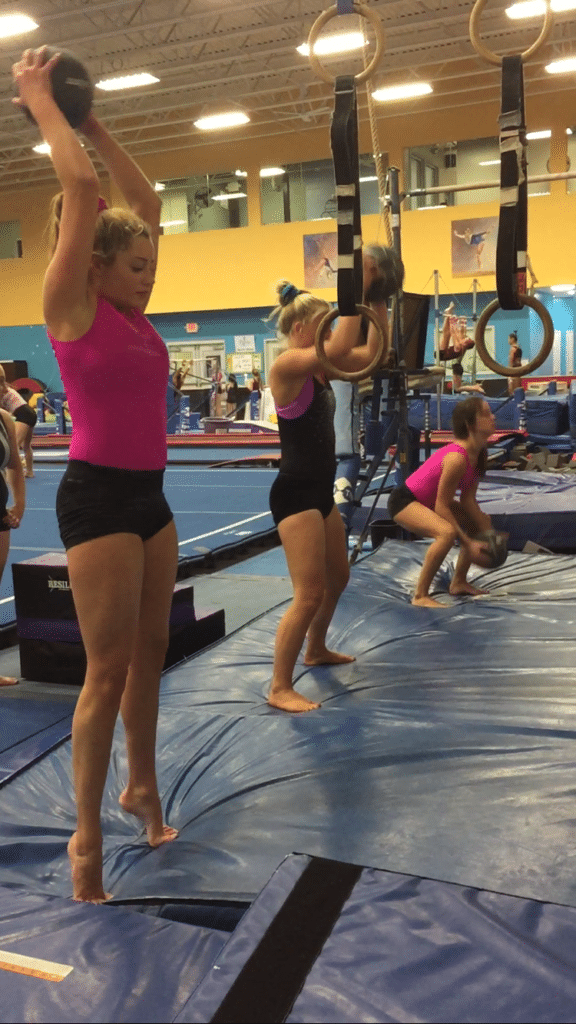
In-Season Programming
The goal during an in-season program is to significantly increase gymnastics-specific fitness (routine competency) while maintaining the majority of the strength acquired during the off-season training. The microcycles then should be very fluid and individualized based on the needs of each athlete specifically and the competitive schedule for each. The in-season program should reflect this flexibility in that each athlete should be focused on specific basic strength, mobility, and gymnastics-based goals.
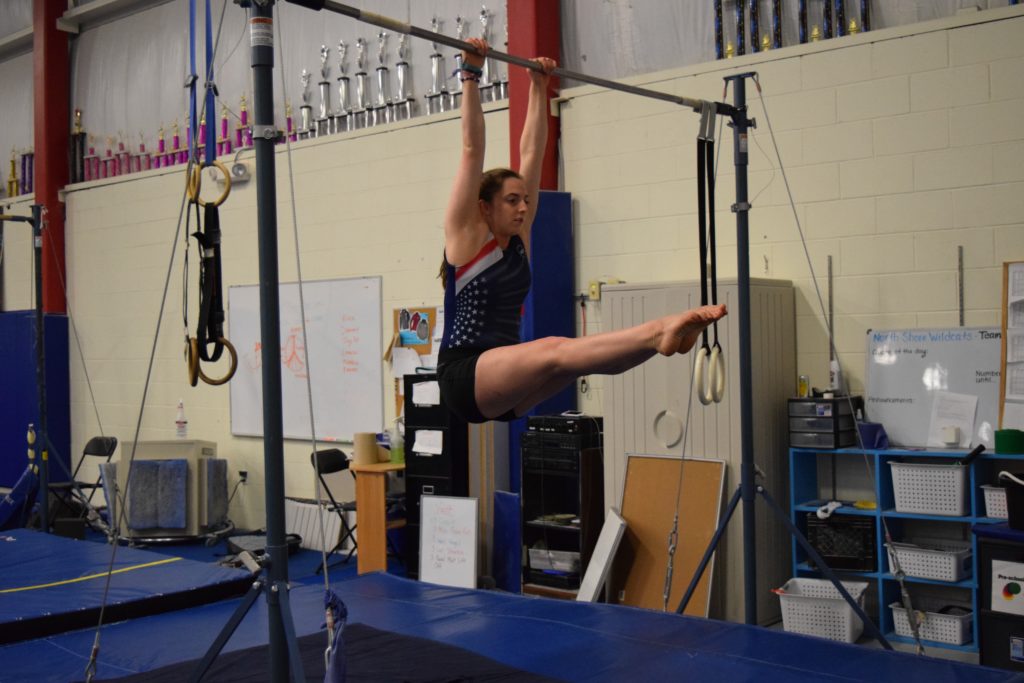
Programming for Younger Athletes
When training younger athletes there are a few concepts which should guide your strength and conditioning programming. When followed they will yield an appropriate adaptational response and quality execution of movement.
- Position is everything
- Mechanics, Consistency, Intensity
- Regularly train at or near maximal rate of force development (provided technique remains solid)
- Many drills are gymnastics-specific conditioning work
Future posts will provide examples of each phase of the annual strength program in order to give a clearer picture of how these concepts are actually implemented into a gymnastics training program.
– Rupert
Rupert Bio:
Rupert has been involved in the sport of gymnastics since he was 10 years old. He was a member of the varsity Men’s gymnastics team at the College of William and Mary where he earned a Bachelor of Science in Neuroscience. He attended graduate school at Georgetown University where he earned a Master of Science in Physiology. While at Georgetown, he helped design a translational exercise physiology course for health care professionals, published research papers in peer-reviewed journals, and interned within the Sports Performance department.
Rupert has applied experience as a gymnastics coach, having coached both male and females athletes from the beginner level through college and elite. Most recently he was the head coach and program director at Davis Diamonds Gymnastics in Davis California. He is on staff as a coach for Power Monkey Fitness, coaching at their bi-annual athlete training camps. He currently works with many crossfit athletes on improving their gymnastics-based movement and strength.
Certifications:
- USA Gymnastics- National Coach
- National Academy of Sports Medicine – Performance Enhancement Specialist
Resources:
- Bompa, Tudor O., Haff, Gregory G., Periodization: Theory and Methodology of Training; fifth edition. Human Kinetics 2009
- Zatsiorsky, Vladimir M., Kraemer, William J., Science and Practice of Strength Training; second edition. Human Kinetics 2006
- Sands, Wm A., Strength and Power Training: 2004 USAG Congress presentation
- Hristov, Hristo., How to design strength training programs using Prilepin’s Table

